- Submissions

Full Text
Associative Journal of Health Sciences
Prevalence of Acute Coronary Syndrome among Diabetic Patients Admitted to Al-Wahdah Teaching Hospital, Yemen
Mohammed Ali Al Huhi*, Daifullah Jayed, Abdulsalam Al Mekdad, Mohammed Qassim Salah and Hadi Mujlli
Associated professor of cardiology, department of internal medicine, Faculty of Medicine and Health Science, Thamar University, Yemen
*Corresponding author:Mohamed Ali Al-Huthi, Associated professor of cardiology, department of internal medicine, Faculty of Medicine and Health Science, Thamar University, Yemen
Submission: March 15, 2023;Published: May 17, 2023

ISSN:2690-9707 Volume2 Issue4
Abstract
Background: According to American heart association, coronary artery diseases are the leading cause of
mortality and morbidity among diabetic patients. Although is more often silent in patients with diabetes
but it usually manifests later on as heart failure.
Aim: this study aimed to determine the prevalence of acute coronary syndrome and associated risk
factors among diabetic patients admitted to AL-Washday teaching hospital, Dharma Governorate, Yemen.
Methods: All patients admitted to Al-Washday teaching hospital with acute coronary syndrome on top
of diabetes mellitus in the last two years 2020-2021. All patients are subjected to clinical evaluation,
baseline ECG, results of laboratory investigations and treatment strategies.
Result: In our study, the overall prevalence of coronary artery diseases among diabetic patients is 24.5%
(53). Analysis of risk factors reveals most patients were hypertensive 66%, also many patients had other
risk factors such as Khat chawing 47%, smoking 21%, and Shammah 7.5% which farther aggravates the
risk. It also shows that the prevalence of STEMI 34%, NSTEMI 19%, and unstable angina 26%, other
patients present with AF, LVH, and non-specific ST segment and T wave changes.
Conclusion: we could be concluded that the prevalence of coronary artery diseases among diabetic
patients estimated to be 24.5%. Most patients with acute coronary syndrome were hypertensive 66%
and increased rate if silent acute coronary syndrome. acute coronary syndrome in Yemeni individuals
with DM was associated with increase in age and increase in duration of diabetes mellitus. Keeping
chronic diseases under control and avoiding bad habits will affect positively to improve the outcome of
DM. Females were affected more than males.
Keywords:Acute coronary syndrome; Diabetic patients
Abbreviations:DM: Diabetes mellitus; ACS: Acute Coronary Syndrome; ACS: Among DPs Acute Coronary Syndrome in Diabetic Patients; MI: Myocardial Infarction; STEMI: ST Segment Elevation Myocardial Infarction; NSTEMI: Non ST Segment Elevation Myocardial infarction; USA: UN Stable Angina; IHD: Ischemic Heart Disease; AHA: American Heart Association; ESC: European Society of Cardiology; HF: Heart Failure; LBBB: Left Bundle Branch Block; ECG: Electrocardiogram; CXR: Chest X Ray; CBC: Complete Blood Count; NYHA: New York Heart Association; LVF: Left Ventricular Failure; ICU: Intensive Care Unit; BP: Blood Pressure; JVP: Jugular Venous Pulse; MR: Mitral Regurgitation; PCI: Percutaneous Coronary Intervention; CABG: Coronary Artery Bypass Graft; UFH: Unfractionated Heparin; LMWHs: Low Molecular Weight Heparin; GRACE: Global Registry of Acute Coronary Events; RBS: Random Blood Sugar; FBS: Fasting Blood Sugar; HBA1C: Glycosylated Hemoglobin; RFT: Renal Function Test; LVH: Left Ventricular Hypertrophy; AF: Atrial Fibrillation
Background
Coronary artery diseases (CAD) are the leading causes of mortality and morbidity among diabetic patients [1]. As diabetic patients are more likely to experience acute myocardial infarction, they are also at greater risk of dying after acute cardiac event or even at least develop woes prognosis than non-diabetic patients. [2,3].
Several mechanisms play role in making acute coronary syndrome (especially MI) the leading cause of death in diabetics the most important mechanisms are: macroangiopathy with accelerated atherosclerosis and hypertension, microangiopathy with related endothelial dysfunction and disturbed plate late function, autonomic neuropathy, and Metabolic alternation with generation, accumulation of free radicals and alternation of ions homeostasis [4].
Therefore, among all patients with acute coronary syndrome (ACS) those with Diabetes Mellitus (DM) are at particularly high risk of recurrent cardiovascular events and premature death [2,3].
CAD is the leading cause of death in diabetic patients and it’s also the most common cause of hospitalization and intensive care unit admission in diabetics. Therefore, this study will provide information to researchers and readers about prevalence and risk factors associated with ACS among Diabetic patients.
Aim
To determine the prevalence of acute coronary syndrome and associated risk factors among diabetic patients
Material and Methods
Study design
A cross-sectional, hospital-based study was conducted among ACS patients from 2020 to 2021.
Study setting
This study was carried out in internal medicine department in Al-Wahdah teaching hospital, Thamar government, Yemen.
Study population
All patients who had admitted with diagnosis of ACS with DM to in internal medicine department in Al-Wahdah teaching hospital. The inclusion criteria of the study were all patients who present with ACS on top of diabetes mellitus and the exclusion criteria those patients who present with DM or its complications without ACS.
Sampling methods
All patients admitted to the internal medicine department in Al- Wahdah teaching hospital, Thamar government from 2020-2021 were enrolled in the study.
Data collection and Tool
Data were collected as from document and records and a faceto- face interview with patients using questionnaire for assessing the prevalence of acute coronary syndrome and associated risk factors among diabetic patients which covered the following: The first section, was related to demographic characteristics. The information included: Age, gender, educational level, and marital status. The second section was the clinical data. Patients’ clinical data was documented on files- focusing on symptoms) chest pain: At rest, on exertion, not present. Dyspnea: at rest, on exertion, not present. Other symptoms as: lower limb edema, palpitation, dizziness) [5].
Cardiopulmonary examination
(Heart sounds: weak, normal, add sounds. Crepitation: no basal, all over). Patients’ investigation was documented on the sheets including laboratory investigations (RBS, HBA1C, Cardiac enzymes, CBC, RFT, LFT, Serum electrolytes and lipid profiles) and radiological tests (ECG and CXR). The data that suggest risk factors such as family history, long duration of DM, smoking, hypertension, and Khat chewing and Shammah [6].
Data analysis
Analysis was performed using statistical package for social science (SPSS). Demographic characteristics and clinical history of the patients were presented in terms of frequency and percentage. Chi-square was used to find out the association between factors and the ACS outcome [7].
Ethical consideration
Approval was obtained before carrying out this study from Al- Wahdah teaching hospital to conduct this study. Oral consent was obtained upon agreeing to participate in the study.
Result
Demographic characteristics
The demographic characteristics of the patients is presented in Table 1. It was found that about 47% of the patients were male. The age group > 60 years was representing 57%, all of them married 100% and 57% were uneducated (Tables 1-8) (Figures 1-3).
Table 1:Demographic characteristics among patients.
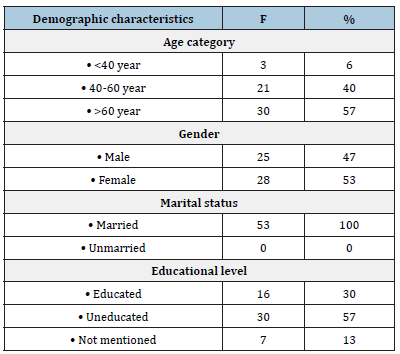
Table 2:Prevalence of ACS among diabetic patients.

Table 3:Clinical data of responders.
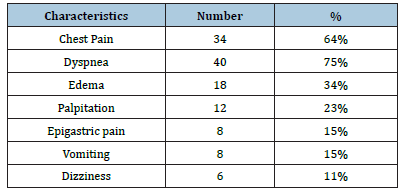
Table 4:
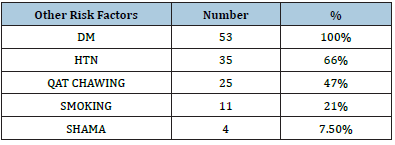
Table 5:physical examination of patient of ACS with DM on admission.
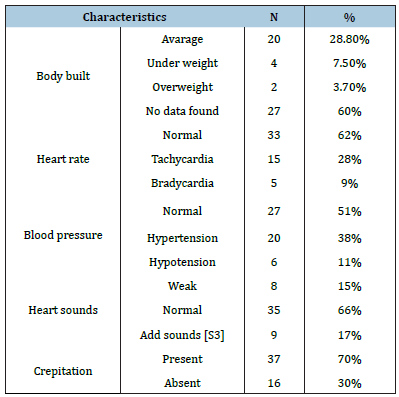
Table 6:Laboratory Investigations.
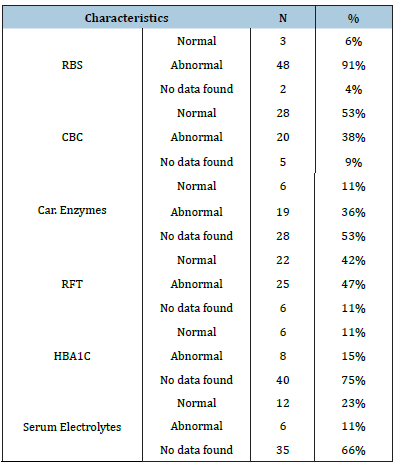
Table 7:ECG abnormalities.
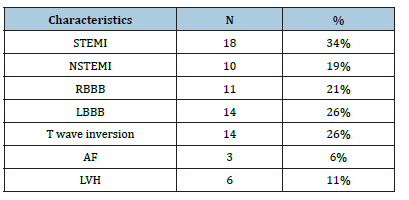
Table 8:Pharmacological and non-pharmacological treatments.
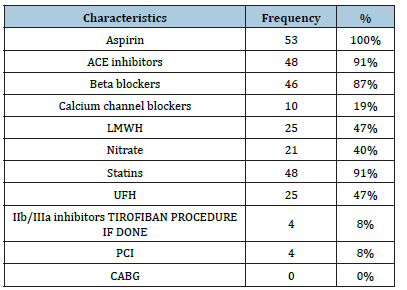
Figure 1:Prevalence of ACS among diabetic patients.
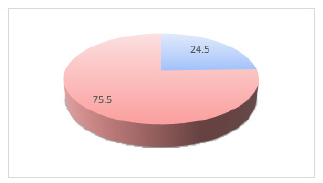
Figure 2:Risk factors of ACS among diabetic patients.
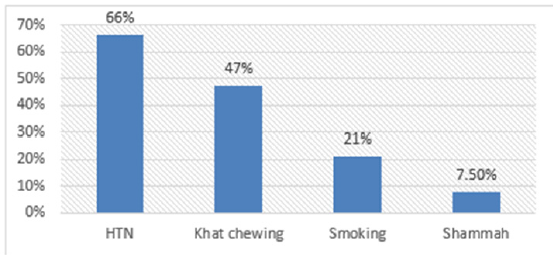
Figure 3:ECG abnormalities.
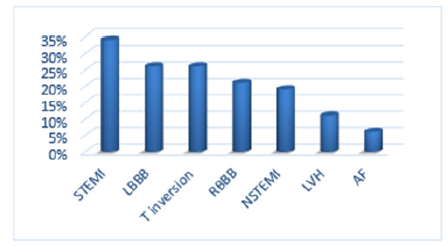
Discussion
The current study done on 216 hospitalized patients who admitted as case of diabetes mellitus in Al- Wahda teaching hospital in Thamar governorate, Yemen. In our population study, the overall prevalence of ACS among diabetic patients is 24.5% (53). These results agree with some previous studies. In our study, we observed that female patients 28 (53%) were slightly more than male patients 25(47%). 3 (6%) of all patients with ACS are less than the age of 40, whereas 21 (40%) between 40-60, and 30 (57%) are more than the age of 60 years, which indicates that risk of ACS increased significantly above 40 years old, although most patients are above the age of 60.
In the current study, the characteristic chief complaint of patients on presentation. Were dyspnea 40 (75%), chest pain 34(64%), edema 18 (34%), palpitation 12 (23%), epigastric pain and vomiting 8 (15%) which indicates high incidence of atypical manifestations (dyspnea, and edema) of ACS and therefore high incidence of silent ACS in diabetic patients. Analysis of risk factors reveals most patients were hypertensive 35(66%). These results are consistent with previous studies, also many patients had other risk factors as Khat chawing 25(47%), smoking 11(21%), and Shammah 4 (7.5%) which farther aggravates the risk [8-13].
The result of the current study also shows that the prevalence of STEMI 18 (34%), NSTEMI 10 (19 %), and unstable angina 14 (26%). These results are consistent with previous studies, other patients present with AF, LVH, and non-specific ST segment and T wave changes. People need access to learn about their major risk factors to avoid, and the importance of diabetes control as DM plays the most important role. Additionally, the study results could have been affected by unmeasured confounding variable socioeconomic state and post hospital care.
Conclusion
The prevalence of ACS among diabetic patients is estimated to be 24.5%. Most patients with ACS were hypertensive 66% and increased rate if silent ACS. ACS in Yemeni individuals with DM was associated with increase in age and increase in duration of DM. Females were affected more than males.
Recommendations
Keeping chronic diseases under control and avoiding bad habits will affect positively to improve the outcome of DM. Provide access for patients to learn about their disease and possible complications, to work with their doctors achieve better glycemic control. Aggressive treatment of hypertension and hyperlipidemia solely on the basis of diabetes status. and correction of modifiable risk factors. Such as smoking, obesity, Shammah and Khat chowing.
References
- Franklin K, Goldberg RJ, Spencer F, Klein W, Budaj A, et al. (2004) Implications of diabetes in patients with acute coronary syndromes. The Global Registry of Acute Coronary Events. Arch Intern Med 164(13): 1457-1463.
- Herlitz J, Malmberg K, Karlson BW, Ryden L, Hjalmarson A (1988) Mortality and morbidity during a five-year follow-up of diabetics with myocardial infarction. Acta Med Scand 224(1): 31-38.
- Galcera Tomas J, Melgarejo Moreno A, Garcia Alberola A, Rodríguez García P, Lozano Martínez J, et al. (1999) Prognostic significance of diabetes in acute myocardial infarction. Are the differences linked to female gender? Int J Cardiol 69(3): 289-298.
- (2020) WikiMed Medical Encyclopedia.
- Dotevall A, Hasdai D, Wallentin L, Battler A, Rosengren A (2005) Diabetes mellitus: Clinical presentation and outcome in men and women with acute coronary syndromes. Data from the Euro Heart Survey ACS. Diabet Med 22(11): 1542-1550.
- Davidson’s Principles and Practice. In: Ralston SH (Ed.), Arthritis Research UK Professor of Rheumatology, Honorary Consultant Rheumatologist, University of Edinburgh, UK.
- ESC Guidelines for the management of acute coronary syndromes special situations diabetes mellitus.
- (2016) Amr el Hadidy consultant of interventional cardiology prof of CCM Cairo university. Egypt.
- Graham I, Atar D, Borch Johnsen K, Boysen G, Burell G, et al. (2007) European guidelines on cardiovascular disease prevention in clinical practice: executive summary: Fourth Joint Task Force of the European Society of Cardiology and Other Societies on Cardiovascular Disease Prevention in Clinical Practice (Constituted by representatives of nine societies and by invited experts). Eur Heart J 28(19): 2375-2414.
- Diaz R, Goyal A, Mehta SR, Afzal R, Xavier D, et al. (2007) Glucose insulin-potassium therapy in patients with ST-segment elevation myocardial infarction. JAMA 298(20): 2399-2405.
- Ahmeda M, Awadallab GH, Elmadhounc WM, Osmand M, Noore SK, et al. (2017) Car Cardiol Res 8(5): 184-189.
- Lettino M, Andell P, Zeymer U, Widimsky P, Danchin N, et al. (2017) Diabetic patients with acute coronary syndromes in contemporary European registries: characteristics and outcomes. European Heart Journal-Cardiovascular Pharmacotherapy 3(4): 198-213.
- Einarson TR, Acs A, Ludwig C, Panton UH (2018) Prevalence of cardiovascular disease in type 2 diabetes: a systematic literature review of scientific evidence from across the world in 2007-2017. Cardiovasc Diabetol 17: 83.
© 2023 Mohammed Ali Al Huhi. This is an open access article distributed under the terms of the Creative Commons Attribution License , which permits unrestricted use, distribution, and build upon your work non-commercially.
 a Creative Commons Attribution 4.0 International License. Based on a work at www.crimsonpublishers.com.
Best viewed in
a Creative Commons Attribution 4.0 International License. Based on a work at www.crimsonpublishers.com.
Best viewed in 







.jpg)






























 Editorial Board Registrations
Editorial Board Registrations Submit your Article
Submit your Article Refer a Friend
Refer a Friend Advertise With Us
Advertise With Us
.jpg)






.jpg)














.bmp)
.jpg)
.png)
.jpg)










.jpg)






.png)

.png)



.png)






